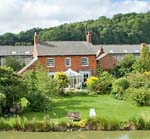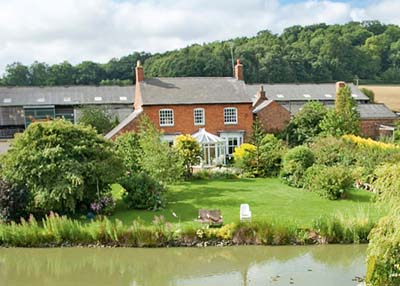Sporting country houses for sale
Smaller estates can be wonderful purchases for fans of country pursuits finds Penny Churchill


Not everyone wants the bother of a country estate, and you don't need to own a multimillion-pound property with thousands of acres to enjoy the pride and pleasure of hunting, shooting or fishing on your own land. On the other hand, as Harry St John of farm specialist Smiths Gore points out, the value of even a relatively modest-sized farm can be greatly enhanced by the presence of sporting assets such as a sizeable block of woodland, a stretch of water on an established fishing river or stabling and paddocks within reach of one, or several, well-known hunts. In fact, with precious little land of any kind for sale at the moment, it's worth seizing those sporting opportunities wherever they can be found.
The sporting element, comprising 114 acres of mixed woodland and several ponds, was ‘much of the attraction' at the 596-acre Marston Lodge Farm, near Market Harborough, on the Northamptonshire/Leicestershire borders, which was launched on the market by Smiths Gore in May at a guide price of excess £4.4 million. After ‘30 viewings, numerous offers and a final hard-fought bidding process', the farm eventually sold for more than £5m. In much the same way, Mr St John reveals, the 170-acre Wood Farm at Lyneham, Wiltshire, made £2m against its original guide price of £1.6m, thanks to the proven sporting potential of its 100 acres of steep-sided woodland.
The shooting fraternity is well used to travelling the length and breadth of Britain in search of the most challenging birds, so a trip to scenic Radnorshire in mid Wales is no big deal. One of few small sporting estates currently on the market-at a guide price of £1.75m through the Ludlow office of Strutt & Parker (01584 873711)-the 225-acre Old Hall estate at Dolau, near the spa town of Llandrindod Wells, Powys, comes with sporting rights over a further 830 acres of adjoining land. It also falls within the bounds of Radnor and West Hereford hunt country.
True to current form, much of the interest in the estate so far has come from lifestyle buyers rather than working farmers, reports selling agent Ben Winson of Strutt & Parker. The special nature of the sport at Old Hall is summed up in The Field's July 2012 review of the UK's top 50 shoots: ‘Shoot manager Rick Hughes and a friendly team of local beaters make this Welsh Marches 150-200-bird pheasant shoot an absolute pleasure. All seven drives in two long Radnorshire valleys can be reached on foot, with birds flushing some 250ft above the guns and flying in a dramatic landscape.'
This part of Radnorshire had an even more eclectic sporting history in the 18th and 19th centuries, when the growth of Llandrindod Wells as a spa town prompted the enterprising Shrewsbury businessman William Grosvenor to convert a nearby farmhouse into the luxury Llandrindod Hall hotel, which eventually burned down in the late 1800s. His sister and brother-in-law were put in charge of running the hotel and Mr Grosvenor and his daughter, Lucy, looked after the outdoor activities, which included cock-fighting, horse-racing and fox, hare, and otter hunting.
Hunting, shooting and point-to-pointing, along with beef and sheep farming, are all part of the scene at Old Hall, which has been owned and improved by the Middleton family since the early 1960s. The present Victorian house at the heart of the estate is thought to stand on the site of a Tudor farmhouse, once home to one of Elizabeth I's land agents. Described by Mr Winson as ‘grandly faded', it has three fine reception rooms, a large kitchen, numerous utility rooms, a master suite, six further bedrooms and a family bathroom. Outbuildings include a modern livestock unit, stabling and barns, and two garages with a billiards/games room overhead. The land is mainly pasture, divided into fields and interspersed with game crops and mature woodland, and was farmed organically until very recently.

If standing waist-deep in one of the West Country's most scenic salmon-and-trout rivers is your idea of sporting heaven, then the Exeter office of Savills (01392 455700) has the answer to your prayers. It's offering the converted stone-and-cob Parkyn's Barn, at Roborough, near Winkleigh, Devon, with its detached two-bedroom cottage and the celebrated Kingford Water beat on the River Taw at Umberleigh, either as a whole or individually, at a guide price of excess £500,000 for the substantial five-bedroom barn, £250,000 for Parkyn's Cottage and £350,000 for the well-established Kingford fishery-£1.1m for the whole. Buyers should note that the cottage and fishery will only be sold separately once a purchaser has been found for Parkyn's Barn.
Sign up for the Country Life Newsletter
Exquisite houses, the beauty of Nature, and how to get the most from your life, straight to your inbox.
It's rare to find a substantial country house surrounded by its own land in the area south of Worksop, Nottinghamshire, known as the Dukeries-so called because it was made up of four ducal seats that were historically owned by the dukes of Newcastle, Kingston, Portland and Norfolk, whose vast estates more or less abutted each other. An exception to the rule is Grade II-listed Harness Grove at Darfoulds, two miles from Worksop, which stands in 50 acres of gardens, parkland, paddocks and woodland on the edge of the Dukeries, and is now being offered for sale through Chesterton Humberts (01159 505444) and Savills (01159 348109) at a guide price of £2.8m.
According to its listing, Harness Grove was built in about 1710, extended in the late 19th century, and again in the 1930s. It stands on land owned by the Earls of Rutland until 1813, when it became part of the Duke of Portland's Welbeck estate. In 1890, however, when a new colliery was opened at Whitwell on land leased from the 6th Duke of Portland, Harness Grove was owned by Henry Hodding, a solicitor and major local landowner, and it was he who supplied most of the land for housing in the area around the mine. But he was careful to retain enough land to safeguard his own privacy and seclusion.
For selling agent Stuart Paton of Chesterton Humberts, Harness Grove's splendid stable yard, manicured post-and-railed paddocks and location within reach of the South Notts and Grove & Rufford hunts, combine to make it an ideal 21st-century hunting box or small stud. Approached through an impressive pillared entrance along a sweeping, tree-lined driveway, the 7,952sq ft main house has been remodelled and renovated with no expense spared. Accommodation on three floors includes five grand reception rooms, a custom-built kitchen/breakfast room, a conservatory, a library, seven bedrooms, five bathrooms, a state-of-the-art leisure complex, a staff annexe, a four-bedroom guest lodge and a further estate house. Amenities include a helicopter pad, a lake and a walled garden.
* Subcribe to Country Life magazine and get our new Ipad version free
Country Life is unlike any other magazine: the only glossy weekly on the newsstand and the only magazine that has been guest-edited by HRH The King not once, but twice. It is a celebration of modern rural life and all its diverse joys and pleasures — that was first published in Queen Victoria's Diamond Jubilee year. Our eclectic mixture of witty and informative content — from the most up-to-date property news and commentary and a coveted glimpse inside some of the UK's best houses and gardens, to gardening, the arts and interior design, written by experts in their field — still cannot be found in print or online, anywhere else.
-
 Athena: We need to get serious about saving our museums
Athena: We need to get serious about saving our museumsThe government announced that museums ‘can now apply for £20 million of funding to invest in their future’ last week. But will this be enough?
By Country Life Published
-
 Six rural properties with space, charm and endless views, as seen in Country Life
Six rural properties with space, charm and endless views, as seen in Country LifeWe take a look at some of the best houses to come to the market via Country Life in the past week.
By Toby Keel Published
